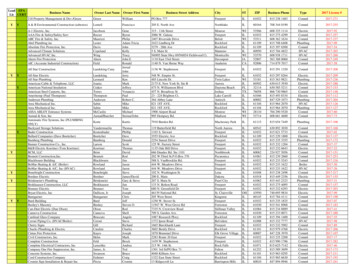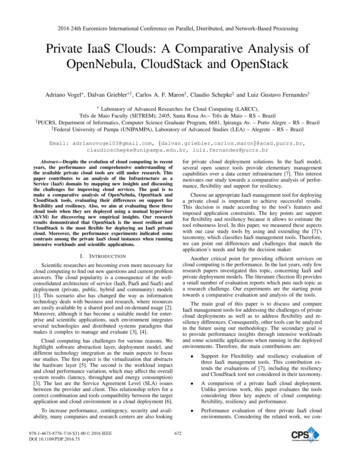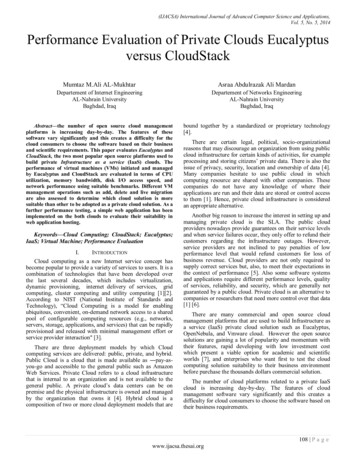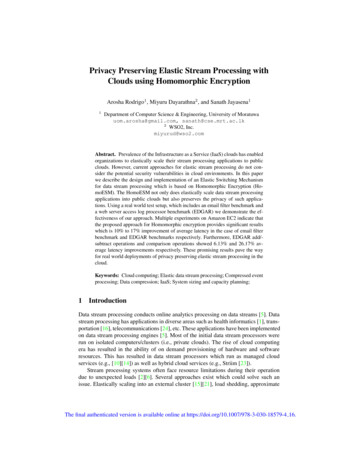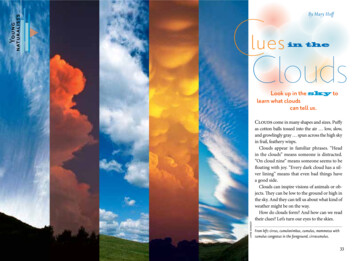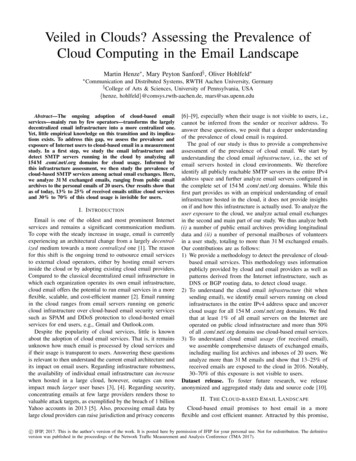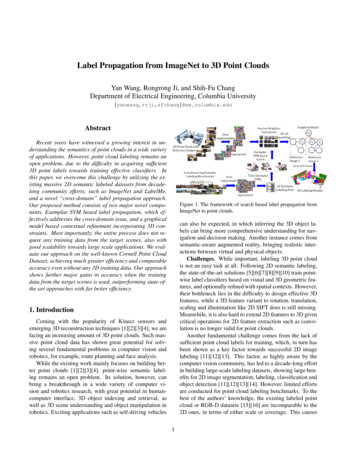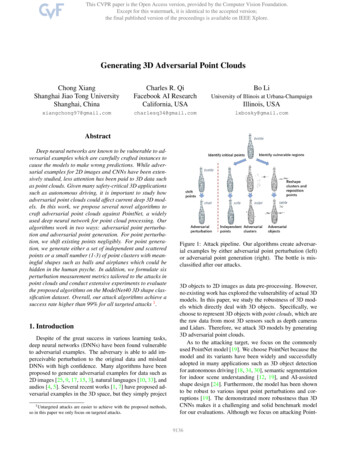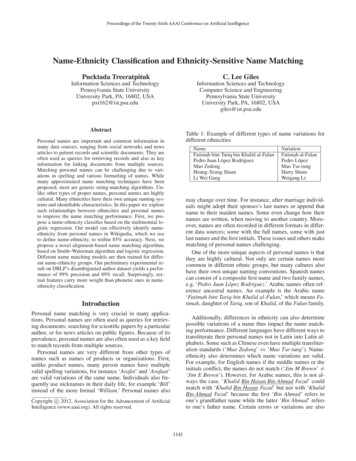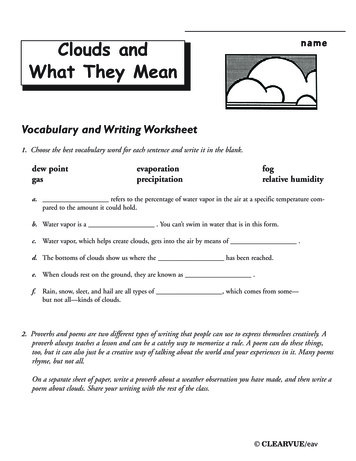
Transcription
nameClouds andWhat They MeanVocabulary and Writing Worksheet1. Choose the best vocabulary word for each sentence and write it in the blank.dew pointgasevaporationprecipitationfogrelative humiditya. refers to the percentage of water vapor in the air at a specific temperature compared to the amount it could hold.b. Water vapor is a . You can’t swim in water that is in this form.c. Water vapor, which helps create clouds, gets into the air by means of .d. The bottoms of clouds show us where the has been reached.e. When clouds rest on the ground, they are known as .f. Rain, snow, sleet, and hail are all types of , which comes from some—but not all—kinds of clouds.2. Proverbs and poems are two different types of writing that people can use to express themselves creatively. Aproverb always teaches a lesson and can be a catchy way to memorize a rule. A poem can do these things,too, but it can also just be a creative way of talking about the world and your experiences in it. Many poemsrhyme, but not all.On a separate sheet of paper, write a proverb about a weather observation you have made, and then write apoem about clouds. Share your writing with the rest of the class. CLEARVUE/eav
nameClouds andWhat They MeanIdentifying Cloud TypesMatch the cloud name to its description. Remember that the altitude of a cloud is important to what kind ofcloud it tratus1.The highest clouds. They are made up of ice crystals and float in thechilly air more than four miles above you. The name for these wispylooking clouds comes from the Latin word for curl. Some people callthem mare’s tails.2.Layered but puffy clouds that occur at middle and lower elevations.3.Thick, puffy clouds that can be found at middle altitudes.4.Low-lying clouds that are generally producers of rain and snow.5.Small cottony rows of cloud tufts that are made of ice crystals andfound at high elevations.6.The big rain cloud, part of its name means clouds, signifying rain to theancient Romans. These clouds can rise to heights of more than 50,000feet. When their tops reach the fast-moving jet stream, they become cirrus-like and are called anvil heads. Some people also call these cloudsthunderheads, because they can bring heavy rain, lightning, and thunder.7.The lowest clouds, they hang like a ceiling at less than 6,000 feet.Their name comes from the Latin word to spread, as in layers. Theseclouds appear as a general overcast and can produce widespread rainand snow.8.Wispy clouds that are found at middle elevations.9.Clouds of vertical development, they get their name from the Latinword for pile or heap. The lowest are the puffy clouds of a summer day.10.Wispy, thin sheets of clouds that are made of ice crystals and foundspreading at high elevations. CLEARVUE/eav
Clouds andWhat They MeannameUnderstanding Temperature ScalesTemperature Worksheet 1Did you know? Two common scales for measuring temperature are Celsius and Fahrenheit, which are both basedon the freezing and boiling points of water. On the Celsius scale, which is part of the metric system and is used inmost parts of the world, the freezing point of water is set at 0 degrees and the boiling point at 100 degrees; on theFahrenheit scale, which is used in the United States, the freezing point of water is set at 32 degrees and the boilingpoint at 212 degrees. By using a mathematical formula, you can convert Fahrenheit temperatures to Celsius temperatures—and vice versa. Formula 1: If you know the temperature in degrees Celsius (C) and you want to find out what it is in degreesFahrenheit: Multiply C x 9. Then, divide your answer by 5. Finally, add 32. Formula 2: If you know the temperature in degrees Fahrenheit (F) and you want to find out what it is in degreesCelsius: Subtract 32 from F (F-32). Then, multiply your answer by 5. Finally, divide that answer by 9.Let’s plug the freezing point of water in degrees Fahrenheitand Celsius into the formulas to see if they work.We know that water freezes at 0 degrees Celsius. Therefore, inthis example C 0. Using Formula 1, we can find out thefreezing point of water in degrees Fahrenheit.Give it a try!Use the back of this page and try a fewconversions yourself. F degrees Fahrenheit C degrees CelsiusFormula 1: C 00x9 00 5 00 32 32F 321. 68 F ? CAs we already know, water freezes at 32 degrees Fahrenheit.3. 30 C ? FLet’s check our answer by using Formula 2.4. 10 C ? FFormula 2: F 3232 - 32 00x5 00 9 0C 0As we know, water freezes at 0 degrees Celsius.2. 104 F ? CFind out for yourself.Look up the words Fahrenheit and Celsius in anencyclopedia and find out how these temperature scales were named. CLEARVUE/eav
Clouds andWhat They MeannameReading a ThermometerTemperature Worksheet 2Answer the following questions, using the thermometer below. On the thermometer, the bigger numbers on theoutside circle indicate degrees Fahrenheit; the smaller numbers inside indicate degrees Celsius.1. When the temperature is 32 degrees Fahrenheit, what is the temperature in degrees Celsius? What do you knowabout this temperature?2. What is the temperature on the thermometer below in degrees Fahrenheit? degrees Celsius?3. Your Canadian pen pal writes you a letter in June and tells you that the temperature—where she lives—hasalready reached 35 degrees Celsius. What is the equivalent temperature in degrees Fahrenheit? Would youexpect that kind of temperature in June? Why or why not?4. What is the temperature outside today in degrees Celsius? in degrees Fahrenheit?5. It’s 5 degrees Celsius outside. What is the approximate temperature in degrees Fahrenheit? Should youdress for warm or cold weather?-1001020-206. One winter morning, you look out the window andsee a dark nimbostratus cloud blanketing the sky.Then, you turn on the radio and the weatherforecaster tells you to expect rain, sleet, and snow allday and a high temperature of 40 degrees Celsius.Which piece of information in this forecast seemswrong? Why?30-3040-40-5050 CLEARVUE/eav
Clouds andWhat They MeannameRecognizing Cloud tratusCirrusRecognizing Clouds–Worksheet 2Using the Cloud Bank, write the name of each cloud next tothe right number below. Remember that it’s important toconsider a cloud’s altitude, or height above ground, whenidentifying cloud types. In addition, think about the wordorigin worksheet you just completed. Use the Latin meanings inthe clouds’ names to figure out what they look like or where theyare located in the ocumulusStratus132.23.4.5.46.7.510698.79.810. CLEARVUE/eav
Clouds andWhat They MeannameUsing Word Origins to Identify CloudsRecognizing Clouds–Worksheet 1Did you know? Latin originated more than 2,500 years ago in ancient Rome and was the primary writtenlanguage of western Europe for hundreds of years, until about 600 years ago when people beganusing their own local languages for writing. But even then, Latin continued to be used as thelanguage of scientists and scholars for another 350 years. As you might imagine, the words of alanguage used for so long and by so many people would creep into many languages. In fact, abouthalf of the words in the English language are of Latin origin.Let’s take a closer look at how Latin and English words are related. Our word nimbostratus—as inthe nimbostratus cloud—for example, is made up of two Latin words. To find out exactly what animbostratus cloud is, we can break apart the word into its Latin parts. In Latin, nimbus means cloud,which signified rain and water to the ancient Romans. Stratus means to spread, as in layers. If we putthese two meanings together, we might reason that a nimbostratus cloud is a gray rain cloud thatspreads across the sky as a general overcast. In fact, our guess is right on target. Nimbostratus cloudsare low-lying clouds that are generally producers of rain and snow.Latin words can be found in many of the names of the cloud types you arestudying. First, look up the five Latin words below in the dictionary and writethe meaning next to each word. Then, using the Cloud Bank at the right, writethe names of the clouds that use the Latin root word(s) in them.Remember: Each Latin word will have more than one cloud type next to it.Some of the cloud types may be used twice.1. tocumulusStratus2. cirro3. cumulus4. nimbus5. stratus CLEARVUE/eav
Clouds andWhat They MeannameQuizIf you need more room to answer the following questions, write onthe back of this sheet or attach an additional paper to the back ofthis sheet.1. What is evaporation?6. Looking up at the sky one afternoon, you see a big,tall cloud that is puffy and white—and looks like itwon’t produce any rain. What type of cloud are youobserving?2. Define dew point.7. As you are getting ready for school one morning, younotice that the sky is gray. Your mother makes youtake a raincoat “just in case” it rains. What types ofclouds are in the sky?3. What is relative humidity? How can it be increased?8. What type of clouds are known as thunderheads, andwhy do some people call them that?4. What are clouds made of? How high off the groundare they?5. Dew point and relative humidity are both importantto the creation of clouds. What is the third scientificprinciple that is essential to cloud formation? Howdoes this principle work—in terms of cloud formation?9. Sometimes, part of a cloud’s name is derived from aLatin word. If you know what this Latin wordmeans, then you can easily figure out certain characteristics of that cloud type. What do these threeLatin words mean? With which cloud types are theyassociated? Why?a. nimbus—b. alto—c. stratus—10. Name three types of precipitation. CLEARVUE/eav
Recognizing Cloud Types Using the Cloud Bank, write the name of each cloud next to the right number below. Remember that it’s important to consider a cloud’s altitude, or height above ground, when identifying cloud types. In addition, think about the word origi
